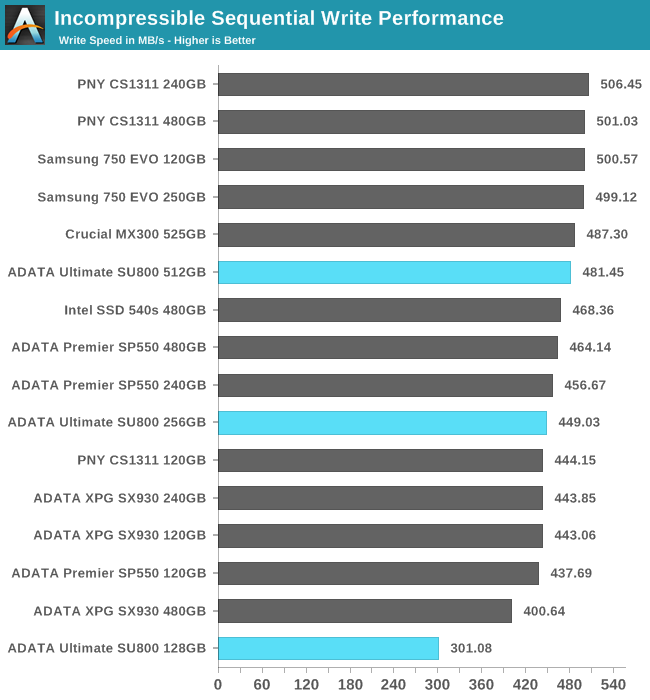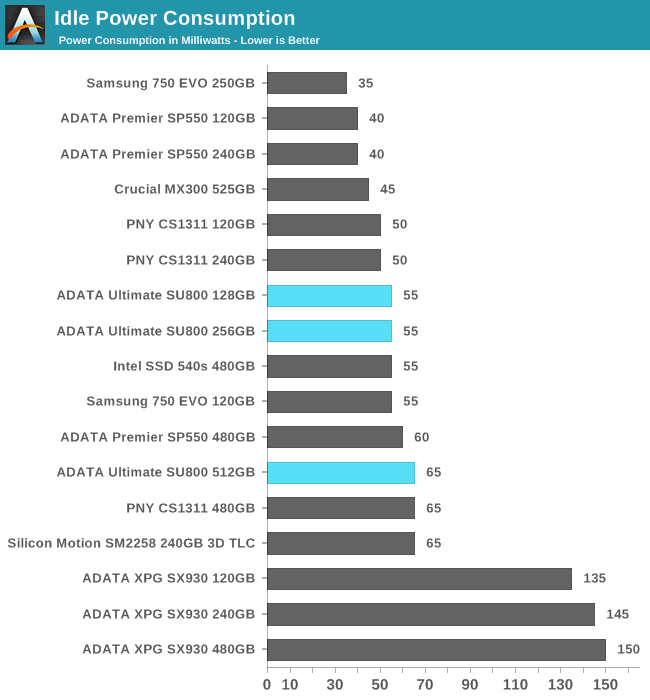The ADATA Ultimate SU800 SSD Review (128GB, 256GB, 512GB)
by Billy Tallis on February 1, 2017 12:01 PM ESTATTO
ATTO's Disk Benchmark is a quick and easy freeware tool to measure drive performance across various transfer sizes.
 |
|||||||||
The inferior write speed of the smallest SU800 is quite clear from the ATTO plots, but there are no other major issues revealed by this test.
AS-SSD
AS-SSD is another quick and free benchmark tool. It uses incompressible data for all of its tests, making it an easy way to keep an eye on which drives are relying on transparent data compression. The short duration of the test makes it a decent indicator of peak drive performance.


All three capacities of the SU800 deliver great sequential read speeds. The low write speed of the 128GB SU800 stands out even on this short test, but the larger capacities are only slightly behind their competition.
Idle Power Consumption
Since the ATSB tests based on real-world usage cut idle times short to 25ms, their power consumption scores paint an inaccurate picture of the relative suitability of drives for mobile use. During real-world client use, a solid state drive will spend far more time idle than actively processing commands. Our testbed doesn't support the deepest DevSlp power saving mode that SATA drives can implement, but we can measure the power usage in the intermediate slumber state where both the host and device ends of the SATA link enter a low-power state and the drive is free to engage its internal power savings measures.
We also report the drive's idle power consumption while the SATA link is active and not in any power saving state. Drives are required to be able to wake from the slumber state in under 10 milliseconds, but that still leaves plenty of room for them to add latency to a burst of I/O. Because of this, many desktops default to either not using SATA Aggressive Link Power Management (ALPM) at all or to only enable it partially without making use of the device-initiated power management (DIPM) capability. Additionally, SATA Hot-Swap is incompatible with the use of DIPM, so our SSD testbed usually has DIPM turned off during performance testing.


The ADATA SU800 achieves respectably low idle power when link power management is used. The active idle power consumption is a problem for all of the drives with Silicon Motion controllers, and worst for the SU800.










35 Comments
View All Comments
RamIt - Wednesday, February 1, 2017 - link
Why is there no comparison to the Intel 600p recently reviewed?extide - Thursday, February 2, 2017 - link
Probably because it is a PCIe drive. A shopper who is shopping for SATA drives is probably not interested in a PCIe drive.dj_aris - Thursday, February 2, 2017 - link
Sorry, but since all SATA 3 drives top at theoretical 600MBs but SSD speeds are WAY faster than that, what is the point in testing them?Death666Angel - Thursday, February 2, 2017 - link
It might just be my eyes, but I see a lot of instances where the drives don't actually achieve the 600MB/s data cap of the SATA3 protocol....dj_aris - Thursday, February 2, 2017 - link
Indeed, but who cares if it's 600 or 500 or even 300, when you can reach 2000+ using modern pcie storage (with similiar prices). SATA is dead, obviously will not be developed anymore, SATA express drives don't even exist. I mean we don't test DVD drives or floppies, right?doggface - Thursday, February 2, 2017 - link
Sata is dead? Seriously?Also, similar prices?
So many things wrong with this post.
Sata SSDs will continue to thrive for years to come. No doubt about that, and while they do, we will need reviews on their performance to help differentiate the good from bad. Especially as the industry continues to peddle TLC and even possibly QLC drives.
vladx - Thursday, February 2, 2017 - link
Upcoming QLC NAND is not something to scowl at. SSD drives using this technology will not be targeted to compete with MLC or even TLC instead they are planned for archival purposes: https://www.pcper.com/news/Storage/FMS-2015-Toshib...Billy Tallis - Thursday, February 2, 2017 - link
SATA isn't dead, but it is a dead end in the same sense that VGA ports are.extide - Thursday, February 2, 2017 - link
Not everyone's system is compatible with and/or cannot boot from NVME drives. There is definitely still a need to have these data points.lopri - Thursday, February 2, 2017 - link
Two of my boards refuse to accept any M.2 drive as a boot drive, leaving me no choice but to go with SATA. Plus SATA is nowhere near dead because it is still much more affordable. Plus there is no convincing argument as to why backups have to be saved in SSDs.